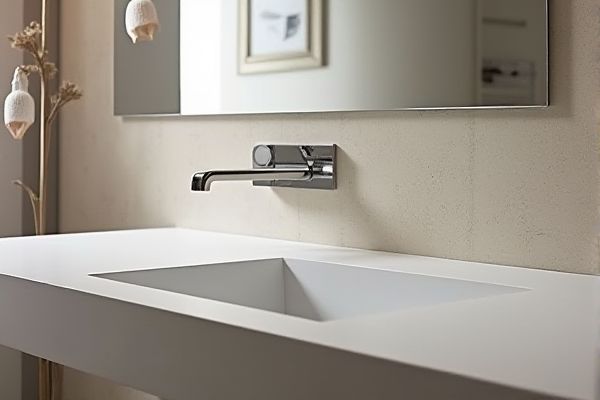
Single basin sinks offer a large, uninterrupted space ideal for washing oversized pots and pans, while double basin sinks provide versatility for multitasking, such as washing dishes on one side and rinsing vegetables on the other. Exploring the benefits and drawbacks of each option will help you choose the perfect sink for your kitchen needs--read on to discover which basin setup suits your lifestyle best.
Table of Comparison
| Feature | Single Basin Sink | Double Basin Sink |
|---|---|---|
| Design | One large basin | Two separate basins |
| Space | More uninterrupted space for large pots | Divides workspace, ideal for multitasking |
| Functionality | Best for washing big items and soaking | Allows washing and rinsing simultaneously |
| Installation | Easier to install, fewer plumbing connections | More complex installation with extra plumbing |
| Maintenance | Simpler cleaning and upkeep | Requires more cleaning due to multiple basins |
| Cost | Generally more affordable | Typically higher cost |
| Usability | Ideal for minimal kitchen tasks | Preferred for multitasking and organized workflow |
Introduction to Single vs Double Basin Sinks
Single basin sinks offer a spacious, uninterrupted area ideal for washing large pots and pans, making them popular in modern kitchens. Double basin sinks provide divided sections that allow multitasking, such as washing dishes on one side while rinsing on the other. Choosing between single and double basin sinks depends on kitchen size, usage habits, and preference for workflow efficiency.
Key Differences Between Single and Double Basin Sinks
Single basin sinks offer a large, uninterrupted space ideal for washing oversized pots and pans, while double basin sinks provide versatility with two separate compartments for multitasking, such as washing dishes in one basin and rinsing in the other. Single basins generally require less countertop space and are easier to clean, whereas double basins allow for organized workflow and can accommodate simultaneous tasks more efficiently. Your choice depends on kitchen size, usage habits, and preference for either ample washing space or divided functionality.
Pros of Single Basin Sinks
Single basin sinks offer expansive space for washing large pots, pans, and baking sheets, making meal prep and cleanup more efficient. Their seamless design minimizes crevices, reducing the risk of dirt buildup and simplifying maintenance. You benefit from versatile functionality, as a single basin allows for multi-purpose use like soaking dishes or filling large containers with water.
Cons of Single Basin Sinks
Single basin sinks lack the versatility of double basin models, making multitasking such as washing dishes and rinsing vegetables simultaneously more challenging. They often provide less organizational efficiency, which can lead to clutter and hinder kitchen workflow. Cleaning large pots and pans can be cumbersome, as the single compartment offers limited space for maneuvering.
Advantages of Double Basin Sinks
Double basin sinks offer enhanced versatility by allowing you to multitask efficiently, such as washing dishes in one basin while rinsing or drying in the other. They provide better organization and separation of dirty and clean items, reducing cross-contamination in your kitchen. The design of double basin sinks can increase overall workspace functionality, making meal prep and cleanup more streamlined.
Disadvantages of Double Basin Sinks
Double basin sinks can limit the available space for washing larger pots and pans, making it challenging to handle bulky kitchenware efficiently. The divider between basins often reduces overall workspace and may complicate cleaning, leading to trapped grime in the seam. Your kitchen workflow might slow down due to the need to manage two separate compartments for rinsing and washing tasks.
Space and Size Considerations
Single basin sinks offer more uninterrupted space, ideal for washing large pots and pans, while double basin sinks provide better organization by separating tasks like washing and rinsing. The size of your kitchen countertop and cabinet underneath should guide your choice, as double basins typically require wider countertop dimensions and more plumbing space. Homeowners with limited kitchen space often prefer a single basin sink to maximize workspace efficiency.
Functionality and Usage Scenarios
Single basin sinks offer ample uninterrupted space, making them ideal for washing large pots, baking sheets, and bulky cookware with ease. Double basin sinks provide versatility by allowing simultaneous tasks such as washing dishes on one side while rinsing vegetables on the other, enhancing workflow efficiency in busy kitchens. Your choice depends on the frequency of multitasking and space requirements to optimize your kitchen's functionality.
Material and Design Options
Single basin sinks are often favored for their spacious interior and versatility, commonly crafted from materials like stainless steel, cast iron, and composite granite to suit various kitchen styles. Double basin sinks provide separation for multitasking, available in materials such as fireclay, porcelain, and stainless steel, offering durability and aesthetic appeal. Both designs offer options that include undermount, drop-in, and farmhouse styles, catering to diverse preferences and functional needs.
Choosing the Right Sink for Your Kitchen Needs
A single basin sink offers a spacious, uninterrupted area ideal for washing large pots and pans, making it a practical choice for those who frequently handle big cookware. Double basin sinks provide versatility by allowing you to separate tasks, such as washing dishes on one side and rinsing vegetables on the other, enhancing your kitchen workflow. Consider your dishwashing habits and the available counter space to determine whether a single or double basin sink best supports your daily kitchen activities.
 homyna.com
homyna.com